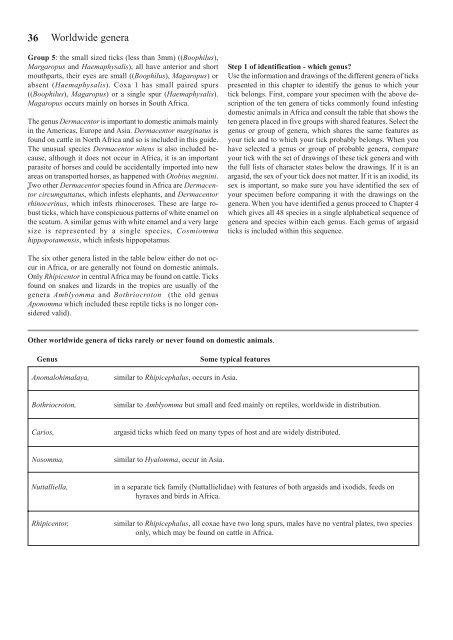Ticks of Domestic Animals in Africa - Alan R Walker - Science Writer
Ticks of Domestic Animals in Africa - Alan R Walker - Science Writer
Ticks of Domestic Animals in Africa - Alan R Walker - Science Writer
You also want an ePaper? Increase the reach of your titles
YUMPU automatically turns print PDFs into web optimized ePapers that Google loves.
36<br />
Worldwide genera<br />
Group 5: the small sized ticks (less than 3mm) ((Boophilus),<br />
Margaropus and Haemaphysalis), all have anterior and short<br />
mouthparts, their eyes are small ((Boophilus), Magaropus) or<br />
absent (Haemaphysalis). Coxa 1 has small paired spurs<br />
((Boophilus), Magaropus) or a s<strong>in</strong>gle spur (Haemaphysalis).<br />
Magaropus occurs ma<strong>in</strong>ly on horses <strong>in</strong> South <strong>Africa</strong>.<br />
The genus Dermacentor is important to domestic animals ma<strong>in</strong>ly<br />
<strong>in</strong> the Americas, Europe and Asia. Dermacentor marg<strong>in</strong>atus is<br />
found on cattle <strong>in</strong> North <strong>Africa</strong> and so is <strong>in</strong>cluded <strong>in</strong> this guide.<br />
The unusual species Dermacentor nitens is also <strong>in</strong>cluded because,<br />
although it does not occur <strong>in</strong> <strong>Africa</strong>, it is an important<br />
parasite <strong>of</strong> horses and could be accidentally imported <strong>in</strong>to new<br />
areas on transported horses, as happened with Otobius megn<strong>in</strong>i.<br />
Two other Dermacentor species found <strong>in</strong> <strong>Africa</strong> are Dermacentor<br />
circumguttatus, which <strong>in</strong>fests elephants, and Dermacentor<br />
rh<strong>in</strong>ocer<strong>in</strong>us, which <strong>in</strong>fests rh<strong>in</strong>oceroses. These are large robust<br />
ticks, which have conspicuous patterns <strong>of</strong> white enamel on<br />
the scutum. A similar genus with white enamel and a very large<br />
size is represented by a s<strong>in</strong>gle species, Cosmiomma<br />
hippopotamensis, which <strong>in</strong>fests hippopotamus.<br />
The six other genera listed <strong>in</strong> the table below either do not occur<br />
<strong>in</strong> <strong>Africa</strong>, or are generally not found on domestic animals.<br />
Only Rhipicentor <strong>in</strong> central <strong>Africa</strong> may be found on cattle. <strong>Ticks</strong><br />
found on snakes and lizards <strong>in</strong> the tropics are usually <strong>of</strong> the<br />
genera Amblyomma and Bothriocroton (the old genus<br />
Aponomma which <strong>in</strong>cluded these reptile ticks is no longer considered<br />
valid).<br />
Other worldwide genera <strong>of</strong> ticks rarely or never found on domestic animals.<br />
Genus Some typical features<br />
Anomalohimalaya, similar to Rhipicephalus, occurs <strong>in</strong> Asia.<br />
Bothriocroton, similar to Amblyomma but small and feed ma<strong>in</strong>ly on reptiles, worldwide <strong>in</strong> distribution.<br />
Carios, argasid ticks which feed on many types <strong>of</strong> host and are widely distributed.<br />
Nosomma, similar to Hyalomma, occur <strong>in</strong> Asia.<br />
Step 1 <strong>of</strong> identification - which genus?<br />
Use the <strong>in</strong>formation and draw<strong>in</strong>gs <strong>of</strong> the different genera <strong>of</strong> ticks<br />
presented <strong>in</strong> this chapter to identify the genus to which your<br />
tick belongs. First, compare your specimen with the above description<br />
<strong>of</strong> the ten genera <strong>of</strong> ticks commonly found <strong>in</strong>fest<strong>in</strong>g<br />
domestic animals <strong>in</strong> <strong>Africa</strong> and consult the table that shows the<br />
ten genera placed <strong>in</strong> five groups with shared features. Select the<br />
genus or group <strong>of</strong> genera, which shares the same features as<br />
your tick and to which your tick probably belongs. When you<br />
have selected a genus or group <strong>of</strong> probable genera, compare<br />
your tick with the set <strong>of</strong> draw<strong>in</strong>gs <strong>of</strong> these tick genera and with<br />
the full lists <strong>of</strong> character states below the draw<strong>in</strong>gs. If it is an<br />
argasid, the sex <strong>of</strong> your tick does not matter. If it is an ixodid, its<br />
sex is important, so make sure you have identified the sex <strong>of</strong><br />
your specimen before compar<strong>in</strong>g it with the draw<strong>in</strong>gs on the<br />
genera. When you have identified a genus proceed to Chapter 4<br />
which gives all 48 species <strong>in</strong> a s<strong>in</strong>gle alphabetical sequence <strong>of</strong><br />
genera and species with<strong>in</strong> each genus. Each genus <strong>of</strong> argasid<br />
ticks is <strong>in</strong>cluded with<strong>in</strong> this sequence.<br />
Nuttalliella, <strong>in</strong> a separate tick family (Nuttallielidae) with features <strong>of</strong> both argasids and ixodids, feeds on<br />
hyraxes and birds <strong>in</strong> <strong>Africa</strong>.<br />
Rhipicentor, similar to Rhipicephalus, all coxae have two long spurs, males have no ventral plates, two species<br />
only, which may be found on cattle <strong>in</strong> <strong>Africa</strong>.


